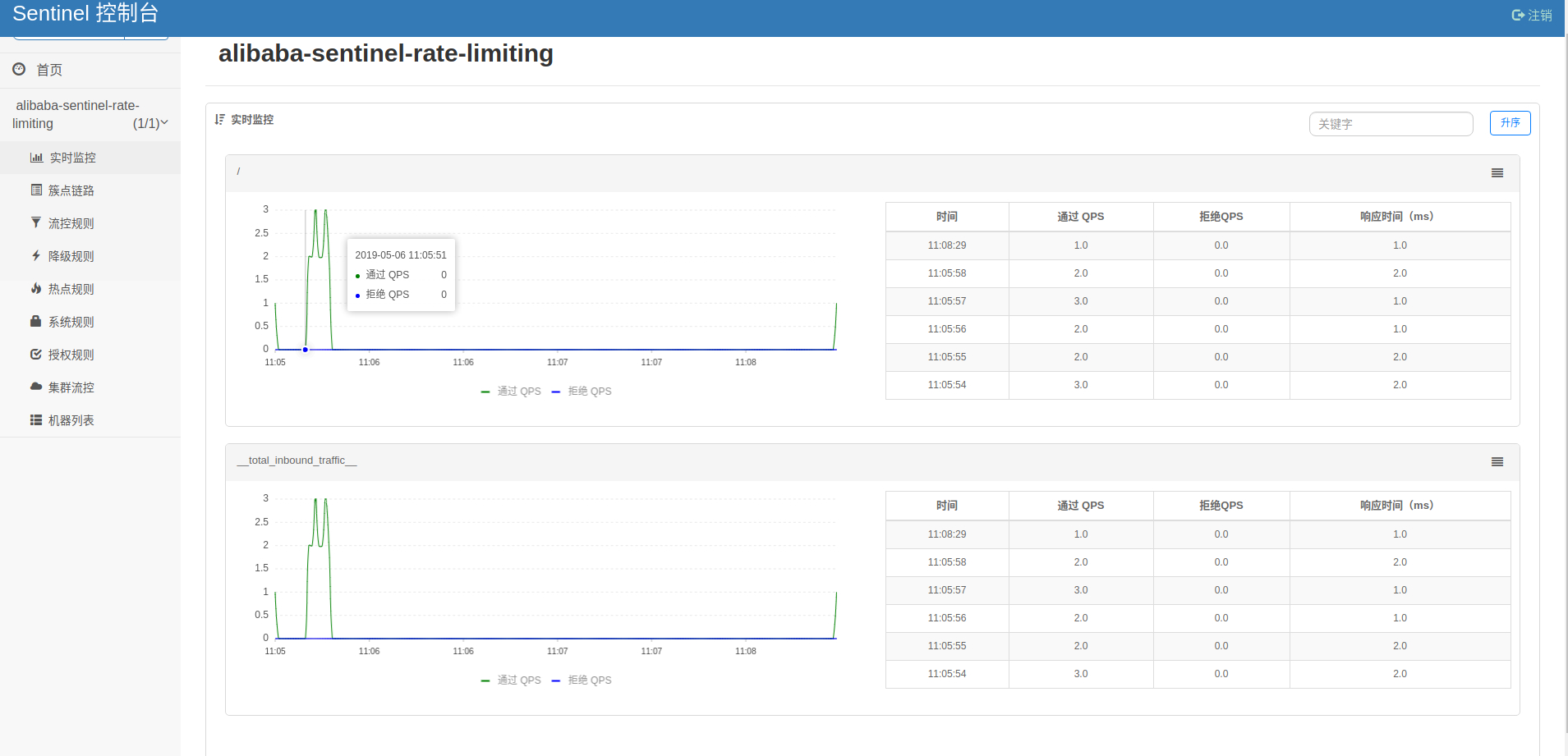使用Sentinel实现接口限流
https://mp.weixin.qq.com/s?__biz=MzAxODcyNjEzNQ==&mid=2247487191&idx=1&sn=a8feb651b9e7dc12a164b1b3b8a82fee&chksm=9bd0a34faca72a594cf8eacc384e40e3176bd2b518c9caa640d3afaa38d75472b9e5d66cfb4d&scene=4 http://www.pianshen.com/article/1148196206/
Nacos作为注册中心和配置中心的基础教程,到这里先告一段落,后续与其他结合的内容等讲到的时候再一起拿出来说,不然内容会有点跳跃。接下来我们就来一起学习一下Spring Cloud Alibaba下的另外一个重要组件:Sentinel。
限流组件Sentinel
Sentinel是把流量作为切入点,从流量控制、熔断降级、系统负载保护等多个维度保护服务的稳定性。
默认支持 Servlet、Feign、RestTemplate、Dubbo 和 RocketMQ 限流降级功能的接入,可以在运行时通过控制台实时修改限流降级规则,还支持查看限流降级 Metrics 监控。
自带控台动态修改限流策略。但是每次服务重启后就丢失了。所以它也支持ReadableDataSource 目前支持file, nacos, zk, apollo 这4种类型
Sentinel是什么
Sentinel的官方标题是:分布式系统的流量防卫兵。从名字上来看,很容易就能猜到它是用来作服务稳定性保障的。对于服务稳定性保障组件,如果熟悉Spring Cloud的用户,第一反应应该就是Hystrix。但是比较可惜的是Netflix已经宣布对Hystrix停止更新。那么,在未来我们还有什么更好的选择呢?除了Spring Cloud官方推荐的resilience4j之外,目前Spring Cloud Alibaba下整合的Sentinel也是用户可以重点考察和选型的目标。
Sentinel的功能和细节比较多,一篇内容很难介绍完整。所以下面我会分多篇来一一介绍Sentinel的重要功能。本文就先从限流入手,说说如何把Sentinel整合到Spring Cloud应用中,以及如何使用Sentinel Dashboard来配置限流规则。通过这个简单的例子,先将这一套基础配置搭建起来。
使用Sentinel实现接口限流
Sentinel的使用分为两部分:
sentinel-dashboard:与hystrix-dashboard类似,但是它更为强大一些。除了与hystrix-dashboard一样提供实时监控之外,还提供了流控规则、熔断规则的在线维护等功能。
客户端整合:每个微服务客户端都需要整合sentinel的客户端封装与配置,才能将监控信息上报给dashboard展示以及实时的更改限流或熔断规则等。
下面我们就分两部分来看看,如何使用Sentienl来实现接口限流。
部署Sentinel Dashboard
本文采用的spring cloud alibaba版本是0.2.1,可以查看依赖发现当前版本使用的是sentinel 1.4.0。为了顺利完成本文的内容,建议挑选同版本的sentinel dashboard来使用是最稳妥的。
下载地址:https://github.com/alibaba/Sentinel/releases/download/1.4.0/sentinel-dashboard-1.4.0.jar
其他版本:https://github.com/alibaba/Sentinel/releases
同以往的Spring Cloud教程一样,这里也不推荐大家跨版本使用,不然可能会出现各种各样的问题。
通过命令启动:
sentinel-dashboard不像Nacos的服务端那样提供了外置的配置文件,比较容易修改参数。不过不要紧,由于sentinel-dashboard是一个标准的spring boot应用,所以如果要自定义端口号等内容的话,可以通过在启动命令中增加参数来调整,比如: -Dserver.port=8888
默认情况下,sentinel-dashboard以8080端口启动,所以可以通过访问: localhost:8080来验证是否已经启动成功
默认用户名和密码是:sentinel/sentinel

整合Sentinel
第一步:在Spring Cloud应用的 pom.xml中引入Spring Cloud Alibaba的Sentinel模块:
第二步:在Spring Cloud应用中通过 spring.cloud.sentinel.transport.dashboard参数配置sentinel dashboard的访问地址,比如:
第三步:创建应用主类,并提供一个rest接口,比如:
第四步:启动应用,然后通过postman或者curl访问几下 localhost:8001/接口
此时,在上一节启动的Sentinel Dashboard中就可以当前我们启动的 alibaba-sentinel-rate-limiting这个服务以及接口调用的实时监控了。具体如下图所示:

配置自定义限流规则(@SentinelResource埋点)
自定义限流规则就不是添加方法的访问路径。 配置的是@SentinelResource注解中value的值。比如@SentinelResource("resource")就是配置路径为resource
@SentinelResource 注解包含以下属性:
value: 资源名称,必需项(不能为空)
entryType: 入口类型,可选项(默认为 EntryType.OUT)
blockHandler:blockHandlerClass中对应的异常处理方法名。参数类型和返回值必须和原方法一致
blockHandlerClass:自定义限流逻辑处理类

基本的限流处理就完成了。 但是每次服务重启后 之前配置的限流规则就会被清空因为是内存态的规则对象.所以下面就要用到Sentinel一个特性ReadableDataSource 获取文件、数据库或者配置中心是限流规则
读取文件的实现限流规则
一条限流规则主要由下面几个因素组成:
resource:资源名,即限流规则的作用对象
count: 限流阈值
grade: 限流阈值类型(QPS 或并发线程数)
limitApp: 流控针对的调用来源,若为 default 则不区分调用来源
strategy: 调用关系限流策略
controlBehavior: 流量控制效果(直接拒绝、Warm Up、匀速排队)
SpringCloud alibaba集成Sentinel后只需要在配置文件中进行相关配置,即可在 Spring 容器中自动注册 DataSource,这点很方便。配置文件添加如下配置
Last updated
Was this helpful?